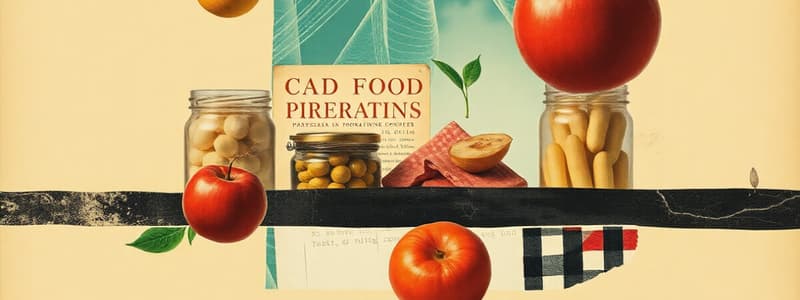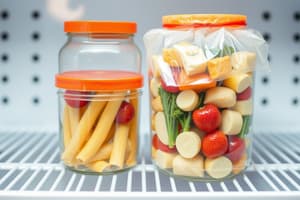Podcast
Questions and Answers
What is the primary focus of food preservation methods?
What is the primary focus of food preservation methods?
- Maximizing flavor and taste
- Understanding and analyzing the complete food chain (correct)
- Enhancing aesthetic appeal of food
- Reducing production costs
What does shelf life indicate?
What does shelf life indicate?
- The time a product can be stored and remain suitable for consumption (correct)
- The maximum amount of nutrients contained in a food product
- The cost-effectiveness of food production
- The environmental impact of food packaging
Which factor is NOT mentioned as affecting the shelf life of food?
Which factor is NOT mentioned as affecting the shelf life of food?
- Nutritional content (correct)
- Packaging
- Processing method
- Storage conditions
Why is predicting shelf life particularly useful for new food products?
Why is predicting shelf life particularly useful for new food products?
What is essential when identifying which properties to preserve in food?
What is essential when identifying which properties to preserve in food?
Flashcards
Integrated approach to food preservation
Integrated approach to food preservation
Considering the whole food chain, from growing to distribution, to ensure effective preservation.
Key characteristics for preservation
Key characteristics for preservation
Identifying the specific properties of a food that need to be preserved, considering both positive and negative aspects.
Shelf life of food
Shelf life of food
The period of time a food product can be stored under specific conditions while maintaining its quality and suitability for consumption.
Factors affecting shelf life
Factors affecting shelf life
Signup and view all the flashcards
Predicting shelf life
Predicting shelf life
Signup and view all the flashcards
Study Notes
Fruit and Vegetable Processing: Food Preservation
- Food preservation methods involve a thorough understanding of the entire food chain, encompassing growing, harvesting, processing, packaging, and distribution. This requires an integrated approach.
- Identifying the specific properties needing preservation is crucial. A property beneficial for one product could be detrimental to another.
- Shelf life is defined as the time a product can be stored under specific conditions and remain suitable for consumption.
Factors Affecting Shelf Life
- Processing methods used significantly influence shelf life.
- Packaging plays a critical role in preserving food quality.
- Storage conditions, including temperature and humidity, drastically affect how long a product lasts.
Prediction of Shelf Life
- Substantial progress has been made to predict and monitor shelf life in recent years.
- This is especially valuable for new products without established distribution histories.
- Shelf-life predictions are calculated based on how products deteriorate, along with the rate of this degradation.
Major Quality Loss Mechanisms
- Microbiological: Microorganism growth, off-flavors, and toxin production.
- Enzymatic: Browning and changes in color and flavor.
- Chemical: Color loss, flavor loss (including non-enzymatic browning), nutrient loss, and oxidation-reduction (rancidity).
- Physical: Collapse, controlled release (like flavor encapsulation), crystallization, phase changes, recrystallization, shrinkage, and transport of components.
- Mechanical: Bruising, cracking, and damage due to pressure.
Food Preservation Methods
- Inhibition: This method prevents spoilage by using techniques like low-temperature storage, reducing water activity, decreasing oxygen, increasing carbon dioxide, acidification, fermentation, adding preservatives and antioxidants, controlling pH, freezing, drying, and concentration; also surface coating, structural modification, chemical modifications, gas removal or phase transition changes, using hurdle technology.
- Inactivation: Techniques like sterilization (pasteurization, irradiation, electrifying, pressure treatment, blanching), cooking (e.g., frying, extrusion) using light, sound, and magnetic fields are applied.
- Avoid recontamination: Techniques include packaging, hygienic processing, hygienic storage, aseptic processing, HACCP, GMP, ISO 9000, TQM, and risk analysis and management.
Studying That Suits You
Use AI to generate personalized quizzes and flashcards to suit your learning preferences.




